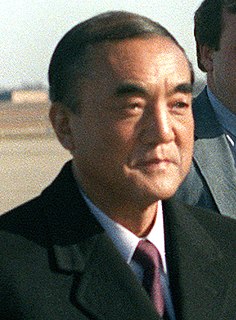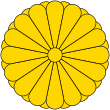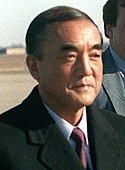
The National Diet is Japan's bicameral legislature. It is composed of a lower house called the House of Representatives, and an upper house, called the House of Councillors. Both houses of the Diet are directly elected under parallel voting systems. In addition to passing laws, the Diet is formally responsible for selecting the Prime Minister. The Diet was first convened as the Imperial Diet in 1889 as a result of adopting the Meiji Constitution. The Diet took its current form in 1947 upon the adoption of the post-war constitution, which considers it the highest organ of state power. The National Diet Building is in Nagatachō, Chiyoda, Tokyo.

The House of Representatives is the lower house of the National Diet of Japan. The House of Councillors is the upper house.

The House of Councillors is the upper house of the National Diet of Japan. The House of Representatives is the lower house. The House of Councillors is the successor to the pre-war House of Peers. If the two houses disagree on matters of the budget, treaties, or designation of the prime minister, the House of Representatives can insist on its decision. In other decisions, the House of Representatives can override a vote of the House of Councillors only by a two-thirds majority of members present.
The Japanese political process has three types of elections: general elections to the House of Representatives held every four years, elections to the House of Councillors held every three years to choose one-half of its members, and local elections held every four years for offices in prefectures, cities, and villages. Elections are supervised by election committees at each administrative level under the general direction of the Central Election Administration Committee, an attached organization to the Ministry of Internal Affairs and Communications (MIC). The minimum voting age in Japan's non-compulsory electoral system was reduced from twenty to eighteen years in June 2016. Voters must satisfy a three-month residency requirement before being allowed to cast a ballot.

Narrandera Shire is a local government area in the Riverina region of south-western New South Wales, Australia. The Shire is located adjacent to the Sturt and Newell Highways.

The Japanese general election, 1986 was an election held in Japan on July 6, 1986, for the House of Representatives.
This is a list of members of the Western Australian Legislative Council from 22 May 1940 to 21 May 1944. The chamber had 30 seats made up of ten provinces each electing three members, on a system of rotation whereby one-third of the members would retire at each biennial election.

A Massachusetts general election was held on November 4, 1986 in the Commonwealth of Massachusetts.

House of Councillors elections were held in Japan on 27 June 1971, electing half the seats in the House. The Liberal Democratic Party won the most seats.
The Hyogo at-large district is a constituency that represents Hyogo Prefecture in the House of Councillors in the Diet of Japan. It currently has five Councillors in the 242-member house, but this representation will increase to six by July 2019.
The Shimane at-large district is a constituency that represents Shimane Prefecture in the House of Councillors in the Diet of Japan. Councillors are elected to the house by single non-transferable vote (SNTV) for six-year terms. Since the establishment of the current House of Councillors electoral system in 1947, the district has elected two Councillors, one each at elections held every three years. With its 576,297 registered voters it is the second-smallest electoral district for the house. Accordingly, a 2015 revision of the Public Officers Election Law will see the district merged with the Tottori At-large district to create the Tottori-Shimane At-large district; this change will begin to take effect at the 2016 election, at which one Councillor will be elected.
The Kochi at-large district is a constituency that represents Kōchi Prefecture in the House of Councillors in the Diet of Japan. Councillors are elected to the house by single non-transferable vote (SNTV) for six-year terms. Since the establishment of the current House of Councillors electoral system in 1947, the district has elected two Councillors, one each at elections held every three years. With its 618,834 registered voters it is the third-smallest electoral district for the house. To address the imbalance in representation between districts, a 2015 revision of the Public Officers Election Law will see the district merged with the Tokushima At-large district to create the Tokushima-Kochi At-large district; this change will begin to take effect at the 2016 election, at which one Councillor will be elected.
The Saga at-large district is a constituency that represents Saga Prefecture in the House of Councillors in the Diet of Japan. Councillors are elected to the house by single non-transferable vote (SNTV) for six-year terms. Since the establishment of the current House of Councillors electoral system in 1947, the district has elected two Councillors, one each at elections held every three years. It has 679,289 registered voters as of September 2015.
The Ibaraki at-large district is a constituency that represents Ibaraki Prefecture in the House of Councillors in the Diet of Japan. It has four Councillors in the 242-member house.
The Chiba at-large district is a constituency that represents Chiba Prefecture in the House of Councillors in the Diet of Japan. It has six Councillors in the 242-member house.
The Niigata at-large district is a constituency that represents Niigata Prefecture in the House of Councillors in the Diet of Japan. It currently has three Councillors in the 242-member house, but this representation will decrease to two by July 2019.
The Ishikawa at-large district is a constituency that represents Ishikawa Prefecture in the House of Councillors in the Diet of Japan. It has two Councillors in the 242-member house.
The Toyama at-large district is a constituency that represents Toyama Prefecture in the House of Councillors in the Diet of Japan. It has two Councillors in the 242-member house.
The Kyoto at-large district is a constituency that represents Kyoto Prefecture in the House of Councillors of the Diet of Japan. It has four Councillors in the 242-member house.

The Japanese National Proportional Representation Block, known in Japan as the House of Councillors proportional district is an electoral district for the House of Councillors, the upper house of the National Diet of Japan. It consists of the whole nation and elects 48 members per election, 96 in total, by D'Hondt method proportional representation (PR).











